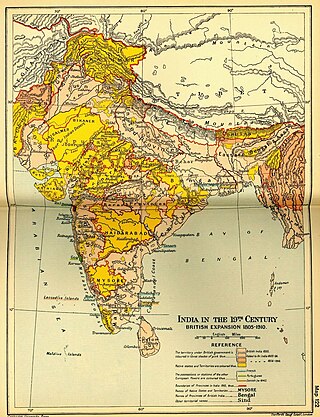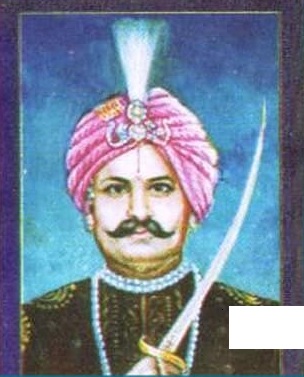
East India Company rule in India was the rule of the British East India Company on the Indian subcontinent. This is variously taken to have commenced between 1757 and 1773. The East India Company ruled India until the company was dissolved in 1858, when, after the Indian Rebellion of 1857 and the Government of India Act 1858, the India Office of the British government assumed the task of directly administering India in the new British Raj.

Awadh, known in British historical texts as Avadh or Oudh, is a historical region in northern India, now constituting the northeastern portion of Uttar Pradesh. It is roughly synonymous with the ancient Kosala region of Hindu, Buddhist, and Jain scriptures.

A jagir, also spelled as jageer, was a type of feudal land grant in the Indian subcontinent at the foundation of its Jagirdar (Zamindar) system. It developed during the Islamic era of the Indian subcontinent, starting in the early 13th century, wherein the powers to govern and collect tax from an estate was granted to an appointee of the state. The tenants were considered to be in the servitude of the jagirdar. There were two forms of jagir, one conditional, the other unconditional. The conditional jagir required the governing family to maintain troops and provide their service to the state when asked. The land grant, called iqta'a, was usually for a holder's lifetime; the land reverted to the state upon the death of the jagirdar.

The United Provinces of Agra and Oudh was a province of India under the British Raj, which existed from 22 March 1902 to 1937; the official name was shortened by the Government of India Act 1935 to United Provinces (UP), by which the province had been commonly known, and by which name it was also a province of independent India until 1950.

The Madras Presidency or Madras Province, officially called the Presidency of Fort St. George until 1937, was an administrative subdivision (province) of British India and later the Dominion of India. At its greatest extent, the presidency included most of southern India, including all of present-day Andhra Pradesh, almost all of Tamil Nadu and parts of Kerala, Karnataka, Odisha and Telangana in the modern day. The city of Madras was the winter capital of the presidency and Ooty was the summer capital.

Kurmi is traditionally a non-elite tiller caste in the lower Gangetic plain of India, especially southern regions of Awadh, eastern Uttar Pradesh and parts of Bihar and Jharkhand. The Kurmis came to be known for their exceptional work ethic, superior tillage and manuring, and gender-neutral culture, bringing praise from Mughal and British administrators alike.

The Permanent Settlement, also known as the Permanent Settlement of Bengal, was an agreement between the East India Company and landlords of Bengal to fix revenues to be raised from land that had far-reaching consequences for both agricultural methods and productivity in the entire British Empire and the political realities of the Indian countryside. It was concluded in 1793 by the Company administration headed by Charles, Earl Cornwallis. It formed one part of a larger body of legislation, known as the Cornwallis Code. The Cornwallis Code of 1793 divided the East India Company's service personnel into three branches: revenue, judicial, and commercial. Revenues were collected by zamindars, native Indians who were treated as landowners. This division created an Indian landed class that supported British authority.
The ryotwari system was a land revenue system in British India introduced by Thomas Munro, which allowed the government to deal directly with the cultivator ('ryot') for revenue collection and gave the peasant freedom to cede or acquire new land for cultivation.
Ryot was a general economic term used throughout India for peasant cultivators but with variations in different provinces. While zamindars were landlords, raiyats were tenants and cultivators, and served as hired labour.

Uyyalawada Narasimha Reddy was an Indian freedom fighter leader. Son of a former Telugu Palegaaru Mallareddy and Seethamma, Narasimha Reddy was born in Rupanagudi village, on 24 November 1806. He belonged to the Motati Clan of Reddys. He and his commander-in-chief Vadde Obanna were at the heart of a freedom movement against Company rule in India in 1847, where 5,000 Indian peasants rose up in revolt against the British East India Company in Nandyal district.
Numbardar or Lambardar was the village headman responsible for tax collection in the village during the British Raj. They were appointed under the Mahalwari system.
Zaildar was an officer in charge of a Zail which was an administrative unit of group of villages during the Sikh Empire, British Indian Empire in Punjab and Dogra dynasty rule in Jammu and Kashmir. The Settlement Officer, with the advice of the Deputy Commissioner, was responsible for appointing Zaildars from amongst the men of the tribe or the area, thus reinforcing his preexisting social authority with the official sanction as the representative of the government. Zaildars were the revenue-collecting officers also responsible for maintaining law and order. The Lambardar and Safedposh assisted the Zaildar. The Zaildar in turn assisted the Deputy Commissioner. The Zaildar was more influential than the Lambardar because a Zail included several villages.
The Economy of India under Company rule describes the economy of those regions that fell under Company rule in India during the years 1757 to 1858. The British East India Company began ruling parts of the Indian subcontinent beginning with the Battle of Plassey, which led to the conquest of Bengal Subah and the founding of the Bengal Presidency, before the Company expanded across most of the subcontinent up until the Indian Rebellion of 1857.
A Village Accountant or Karanam, Patwari, Patowary (Assam), Talati, Lekhpal is a government role in rural areas of the Indian subcontinent. Introduced during the early 16th century, it was maintained by the British Raj. The official, as a representative of the state, is responsible for keeping land records, agricultural records and collecting taxes and acting as the revenue police in certain areas where they were given special jurisdiction.

The East Bengal State Acquisition and Tenancy Act of 1950 was a law passed by the newly formed democratic Government of East Bengal in the Dominion of Pakistan. The bill was drafted on 31 March 1948 during the early years of Pakistan and passed on 16 May 1951. Before passage of the legislature, landed revenue laws of Bengal consisted of the Permanent Settlement Regulations of 1793 and the Bengal Tenancy Act of 1885.

The Zamindars of Bengal were zamindars of the Bengal region of the Indian subcontinent. They governed an ancient system of land ownership.

Lal Pratap Singh was a member of the Bisen Rajput dynasty of Kalakankar. He was prominent leader in the Indian Rebellion of 1857. He was killed during the 1858 Battle of Chanda. The Government of India issued a postage stamp on 17 December 2009 to commemorate him.

The Oudh State was a Mughal subah, then an independent kingdom, and lastly a princely state in the Awadh region of North India until its annexation by the British in 1856. The name Oudh, now obsolete, was once the anglicized name of the state, also written historically as Oudhe.

Kahinjar is a village in Sareni block of Rae Bareli district, Uttar Pradesh, India. It is located 20 km from Lalganj, the tehsil headquarters. Kahinjar historically served as the headquarters of a mahal since at least the time of Akbar, before being merged into the pargana of Sareni under the Nawabs of Awadh. As of 2011, Kahinjar has a population of 2,099 people, in 354 households. It has one primary school and no healthcare facilities. It belongs to the nyaya panchayat of Rasulpur.













